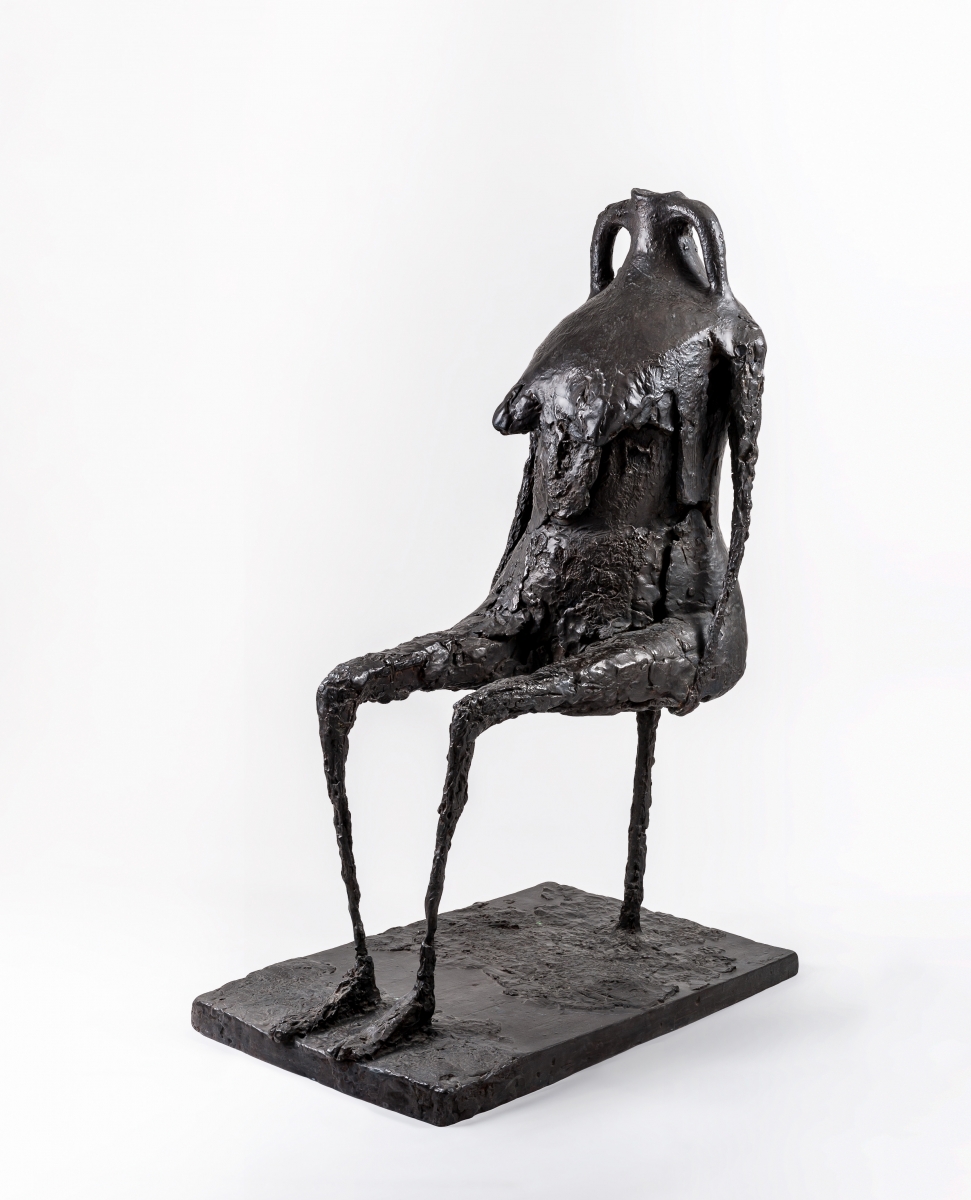
Domenique Lévy and Emmanuel Perrotin have collaborated on presenting a survey of figurative sculptures by Germaine Richier, who Lévy, -- in perhaps, overly bold rhetoric -- claims to have been "the mother of post war sculpture in Europe."
It has been fifty seven years since her first one person show in New York at the Martha Jackson Gallery. Hardly a forgotten figure in France and Europe, during her lifetime she was in five consecutive Venice Biennales, and in recent decades her work has been seen in major surveys of the period: Paris-Paris (1981) at the Centre Pompidou, Aftermath (1982) at the Barbican Art Gallery, Paris Post War (1993) at the Tate Gallery and a retrospective at the Foundation Maeght, Saint-Paul (1996), followed by another at the Academie der Kunst in Berlin (1997). In America, she fell from sight after her untimely death in 1959. The exhibition is on three floors of the two galleries 73th street townhouse. The first floor is overfilled with large pieces; the second is just right; and the third floor holds only a few works which share the space with Gutai artist, Tsuyoshi Maekawa's disappointing variations on Alberto Burri's burlap reliefs. (What were they thinking?)
Apparently, the intensely scarified expressionist surfaces of her work were well known long before Giacometti's wizened figures appeared in his first post-war show in Paris (1951). Still, today Giacometti holds the laurels for the existential desiccation of the human figure, so are we to be as negative as Roberta Smith was in her Times review? Is it just about promotion, "loyalty" to retro media -- bronze and sentimental melodrama? If Giacometti's expressionist adaptation of Rodin's impressionistic use of lights and shadows obsesses on the impossibility of seeing / knowing the "other" and his constant necessity to try; Richier's attenuated proportions and gestures, her use of grafting natural and found forms into clay figures to produce hybrid plant-animal personages seeks to reveal the instinctive nature of the ever shape-shifting inner self. These superficially related artists couldn't be more different.
 I came to the exhibition after seeing the Chiem/Reid exhibition of bronzes by Gaston Lachaise and Louise Bourgeois at the 69th Street Amory. Both of these artists followed their creative demon which caused metamorphic transformations of the human form into concrete emblems of the generative female force in one and the predatory spider-self in the other: both could be said to be mawkish or merely aspects of late surrealism, as in the equally transformative work of Lucas Samaras, whose Polaroids were the most dazzling works in the current ICP's exhibition. For this reviewer, it was hard not to imagine Bourgeois looking back to Richier/s ant woman, "La Fourmi," of 1953, among other works, in much the same way Sigmar Polke or David Salle looked back to Francis Picabia.
I came to the exhibition after seeing the Chiem/Reid exhibition of bronzes by Gaston Lachaise and Louise Bourgeois at the 69th Street Amory. Both of these artists followed their creative demon which caused metamorphic transformations of the human form into concrete emblems of the generative female force in one and the predatory spider-self in the other: both could be said to be mawkish or merely aspects of late surrealism, as in the equally transformative work of Lucas Samaras, whose Polaroids were the most dazzling works in the current ICP's exhibition. For this reviewer, it was hard not to imagine Bourgeois looking back to Richier/s ant woman, "La Fourmi," of 1953, among other works, in much the same way Sigmar Polke or David Salle looked back to Francis Picabia.
Further reflection revealed complex relations with other contemporary European artists. In comparison with the perforations in Richier's "La Chauve-souris," of 1946, or "La Cigale," of 1954-55, or "Le Berger des Landes," of 1951, Lucio Fontana's signature "holes and penetrations" look wearisome. Her bizarrely textured earth spirits, "Plomb avec verre de couleur" from 1952 and another of 1953 seem to precede similar "texturologic" figures by Dubuffet of several years later and hold up well against them. Her metamorphic hybrid figures hold a lively dialogue with contemporary work by Picasso, Miro, and Ernst and have a similar range between success and sentimentality. The single naturalistic bust, "La Chinoise" of 1952, is full of grace and stands with the best portraiture of Marino Marini. Richier's experiments with color came late in her short career and "Le Couple" of 1959 and "Le Menhir peint, sur équerre ardoise," of 1959, show its promise; looking at Brassai's photos of the more animated painted plasters, from "L'Echiquier" also of 1959, made me wish they were on show in place of the whimsical divinatory figures in dark patina.
Indeed this body of work signals something oddly familiar among younger contemporary artists. Both Kiki Smith and Bruce Gagnier have revived the expressionist figure in bronze; and Ruth Marten and JoAnne Carson have in their own way cultivated new gardens of hybrid figurations. The art world has become increasingly global, presenting alternate Modernisms where the present changes perceptions of the past and the past continues to change the present: nothing stays quite the same. - David Carbone
(Photos courtesy of Dominique Lévy Gallery; image above left L'Eau, 1953-1954.)
Mr. Carbone is a painter, a critic, a curator and an educator. He has shown nationally in galleries and museums; written for Modern Painters and The Sienese Shredder anthologies, among other publications; occasionally appeared on NPR's Morning Edition with David D'Arcy between 1992-2005; and curated selected retrospectives. He is currently the director of graduate studies in studio arts at the University at Albany, where he teaches painting.
